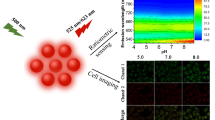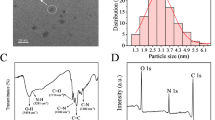Abstract
A dual-mode pH sensor based on nitrogen-doped carbon dots (N-CDs) with the source of o-phenylenediamine and tryptophan has been constructed. Under the stimulation of pH, the N-CDs exhibited prominent both color and fluorescence changes, leading to the rarely discovered colorimetric and fluorescent dual-readouts for the evaluation of pH. The mathematic relationship was established between pH and fluorescence intensity of N-CDs, and between pH and the UV–Vis absorbance ratio at 630 nm and 488 nm of N-CDs, respectively, over a quite broad pH range of 2.2 to 12.0. Multiple techniques are used to explore the dual-mode pH-responsive mechanism, and the preliminary explanation is put forward. The experimental results show that the N-CDs have visualized pH sensing applicability for actual samples, including various water samples and HeLa cell. Furthermore, the N-CD ink is developed for successful information encryption and anti-counterfeiting. This work might provide valuable insights into the sensing mechanism of CDs, and the application potential of CDs in broader fields.
Graphical Abstract









Similar content being viewed by others
Data availability
All relevant data are within the manuscript and the supplementary information. The data that support the findings of this study are available from the corresponding author, Yali Yuan, upon reasonable request.
References
Rizzo R, Onesto V, Morello G, Iuele H, Scalera F, Forciniti S, Gigli G, Polini A, Gervaso F, del Mercato LL (2023) pH-sensing hybrid hydrogels for non-invasive metabolism monitoring in tumor spheroids. Mater Today Bio 20:100655
Wang X, Zhang Y, Shi Z, Lu T, Wang Q, Li B (2021) Multifunctional Zr-MOF based on bisimidazole tetracarboxylic acid for pH sensing and photoreduction of Cr(VI). ACS Appl Mater Inter 13:54217–54226
Wu C, Chen J, Su C (2022) 4D-printed pH sensing claw. Anal Chim Acta 1204:339733
Venkatesan M, Veeramuthu L, Liang F-C, Chen W-C, Cho C-J, Chen C-W, Chen J-Y, Yan Y, Chang S-H, Kuo C-C (2020) Evolution of electrospun nanofibers fluorescent and colorimetric sensors for environmental toxicants, pH, temperature, and cancer cells – a review with insights on applications. Chem Eng J 397:125431
Xu J, Liang C, Gao W, Gao Z, Wu Z, Song Y-Y (2022) Photocatalysis engineered hydrophilic reactors on hydrophobic paper for the visual and colorimetric assay of alkaline phosphatase activity. Microchim Acta 189:343
Zhao C, Li Y, Zhao J, Li H, Xu J, Gao Z, Ding C, Song Y-Y (2023) A “test-to-treat” pad for real-time visual monitoring of bacterial infection and on-site performing smart therapy strategies. ACS Nano 17:13296–13309
Xu J, Liang C, Gao Z, Song Y-Y (2023) Construction of nanoreactors on TiO2 nanotube arrays as a POCT device for sensitive colorimetric detection. Chin Chem Lett 34:107863
Guo J, Xu H, Zhao J, Gao Z, Wu ZQ, Song Y-Y (2022) Locally superengineered cascade recognition–quantification zones in nanochannels for sensitive enantiomer identification. Chem Sci 13:9993–10002
Sun N, Malide D, Liu J, Rovira II, Combs CA, Finkel T (2017) A fluorescence-based imaging method to measure in vitro and in vivo mitophagy using mt-Keima. Nat Protoc 12:1576–1587
Pinto VC, Araújo CF, Sousa PJ, Gonçalves LM, Minas G (2019) A low-cost lab-on-a-chip device for marine pH quantification by colorimetry. Sensor Actual B-Chem 290:285–292
Li H, Lin H, Lv W, Gai P, Li F (2020) Equipment-free and visual detection of multiple biomarkers via an aggregation induced emission luminogen-based paper biosensor. Biosens Bioelectron 165:112336
Mukherjee S, Paul AK, Krishna Rajak K, Stoeckli-Evans H (2014) ICT based ratiometric fluorescent pH sensing using quinoline hydrazones, Sensor. Actual B-Chem 203:150–156
Martínez-Calvo M, Bright SA, Veale EB, Henwood AF, Williams DC, Gunnlaugsson T (2019) 4-amino-1,8-naphthalimide based fluorescent photoinduced electron transfer (PET) pH sensors as liposomal cellular imaging agents: the effect of substituent patterns on PET directional quenching. Front Chem Sci Eng 14:61–75
Chang MJ, Kim K, Park KS, Kang JS, Lim CS, Kim HM, Kang C, Lee MH (2018) High-depth fluorescence imaging using a two-photon FRET system for mitochondrial pH in live cells and tissues. Chem Commun (Camb) 54:13531–13534
Rusishvili M, Grisanti L, Laporte S, Micciarelli M, Rosa M, Robbins RJ, Collins T, Magistrato A, Baroni S (2019) Unraveling the molecular mechanisms of color expression in anthocyanins. Phys Chem Chem Phys 21:8757–8766
Qin X, Lu Y, Bian M, Xiao Z, Zhang Y, Yuan Y (2019) Influence of gold nanoparticles in different aggregation states on the fluorescence of carbon dots and its application. Anal Chim Acta 1091:119–126
Wang L, Li W, Yin L, Liu Y, Guo H, Lai J, Han Y, Li G, Li M, Zhang J, Vajtai R, Ajayan PM, Wu M (2020) Full-color fluorescent carbon quantum dots. Sci Adv 6:eabb6772
Ghadari R, Saei P-S, Sabri A, Ghasemi Z, Kong F (2020) Enhanced phthalocyanine-sensitized solar cell efficiency via cooperation of nitrogen-doped carbon dots. J Clean Prod 268:122236
Chernyak S, Podgornova A, Dorofeev S, Maksimov S, Maslakov K, Savilov S, Lunin V (2020) Synthesis and modification of pristine and nitrogen-doped carbon dots by combining template pyrolysis and oxidation. Appl Surf Sci 507:145027
Bai Y, Zhao J, Wang S, Lin T, Ye F, Zhao S (2021) Carbon dots with absorption red-shifting for two-photon fluorescence imaging of tumor tissue pH and synergistic phototherapy. Appl Mater Inter 13:35365–35375
Wang W, Xia J, Feng J, He M, Chen M, Wang J (2016) Green preparation of carbon dots for intracellular pH sensing and multicolor live cell imaging. J Mater Chem B 4:7130–7137
Yang Z, Xu M, Liu Y, He F, Gao F, Su Y, Wei H, Zhang Y (2014) Nitrogen-doped, carbon-rich, highly photoluminescent carbon dots from ammonium citrate. Nanoscale 6:1890–1895
Zhang T, Dong S, Zhao F, Deng M, Fu Y, Lü C (2019) Tricolor emissive carbon dots for ultra-wide range pH test papers and bioimaging. Sensor Actual B-Chem 298:126869
Ru Y, Sui L, Song H, Liu X, Tang Z, Zang SQ, Yang B, Lu S (2021) Rational design of multicolor-emitting chiral carbonized polymer dots for full-color and white circularly polarized luminescence. Angew Chem Int Ed Engl 60:14091–14099
Zhu Z, Liu C, Song XM, Mao Q, Ma T (2021) Carbon dots as an indicator of acid-base titration and a fluorescent probe for endoplasm reticulum imaging. ACS Appl Bio Mater 4:3623–3629
Sun Y, Qin H, Geng X, Yang R, Qu L, Kani AN, Li Z (2020) Rational design of far-red to near-infrared emitting carbon dots for ultrafast lysosomal polarity imaging. ACS Appl Mater Inter 12:31738–31744
Guo Y, Yang L, Li W, Wang X, Shang Y, Li B (2016) Carbon dots doped with nitrogen and sulfur and loaded with copper(II) as a “turn-on” fluorescent probe for cystein, glutathione and homocysteine. Microchim Acta 183:1409–1416
Liu F, Li Z, Li Y, Feng Y, Feng W (2021) Room-temperature phosphorescent fluorine-nitrogen co-doped carbon dots: information encryption and anti-counterfeiting. Carbon 181:9–15
Su Q, Lu C, Yang X (2019) Efficient room temperature phosphorescence carbon dots: information encryption and dual-channel pH sensing. Carbon 152:609–615
Zhao M, Gao X, Tao Z, Wang X, Lin X, Wang S, Liu Y (2020) Sugar-metabolism-triggered pathogenic bacteria identification based on pH-sensitive fluorescent carbon dots. Sensor Actual B-Chem 316:128063
Li H, Kang Z, Liu Y, Lee S-T (2012) Carbon nanodots: synthesis, properties and applications. J Mater Chem 22:24230–24253
Chen A, Li R, Zhong Y, Deng Q, Yin X, Li H, Kong L, Yang R (2022) A novel chiral fluorescence probe based on carbon dots-copper(II) system for ratio fluorescence detection of gatifloxacin. Sensor Actual B-Chem 359:131602
Yang P, Zhu Z, Zhang T, Zhang W, Chen W, Cao Y, Chen M, Zhou X (2019) Orange-emissive carbon quantum dots: toward application in wound pH monitoring based on colorimetric and fluorescent changing. Small 15:1902823
Liu J, Zhang J, Zhang Y, Wang Y, Wang M, Li Z, Wang G, Su X (2022) A pH-responsive fluorometric and colorimetric system based on silicon quantum dots and 4-nitrophenol for urease activity detection. Talanta 237:122956
Meierhofer F, Dissinger F, Weigert F, Jungclaus J, Müller-Caspary K, Waldvogel SR, Resch-Genger U, Voss T (2020) Citric acid based carbon dots with amine type stabilizers: pH-specific luminescence and quantum yield characteristics. J Phys Chem C 124:8894–8904
Yang J, Guo L, Yong X, Zhang T, Wang B, Song H, Zhao YS, Hou H, Yang B, Ding J, Lu S (2022) Simulating the structure of carbon dots via crystalline π-aggregated organic nanodots prepared by kinetically trapped self-assembly. Angew Chem Int Edit 61:e202207817
Sun Y, Wang X, Wang C, Tong D, Wu Q, Jiang K, Jiang Y, Wang C, Yang M (2018) Red emitting and highly stable carbon dots with dual response to pH values and ferric ions. Microchim Acta 185:83
Shangguan J, He D, He X, Wang K, Xu F, Liu J, Tang J, Yang X, Huang J (2016) Label-free carbon-dots-based ratiometric fluorescence pH nanoprobes for intracellular pH sensing. Anal Chem 88:7837–7843
Wang Z, Peng Z, Ding Y, Du Y (2020) Fourier-filtered, fast wavelength-scanned cavity ring-down spectroscopy. J Opt Soc Am B 37:1144–1152
Zhu J, Chu H, Shen J, Wang C, Wei Y (2022) Carbon quantum dots with pH-responsive orange-/red-light emission for fluorescence imaging of intracellular pH. Microchim Acta 190:21
Dutta Choudhury S, Chethodil JM, Gharat PM, Praseetha PK, Pal H (2017) pH-elicited luminescence functionalities of carbon dots: mechanistic insights. J Phys Chem Lett J Phys Chem Lett 8:1389–1395
Chang D, Zhao Z, Shi H, Feng J, Yang Y, Shi L (2022) Ratiometric fluorescent carbon dots for enantioselective sensing of L-lysine and pH discrimination in vivo and in vitro. Sensor Actual B-Chem 362:131792
Funding
This work was supported by the Guangxi Natural Science Foundation (2020GXNSFBA297116, 2020GXNSFBA297114).
Author information
Authors and Affiliations
Contributions
XZ: conceptualization, investigation, writing—original draft. YP: data curation, writing, investigation. YW: data curation, writing, investigation. WY: data curation. YZ: writing—review and editing. JZ: writing—review and editing. YY: conceptualization, methodology, supervision, writing.
Corresponding author
Ethics declarations
Competing interests
The authors declare no competing interests.
Additional information
Publisher's Note
Springer Nature remains neutral with regard to jurisdictional claims in published maps and institutional affiliations.
Supplementary Information
Below is the link to the electronic supplementary material.
Rights and permissions
Springer Nature or its licensor (e.g. a society or other partner) holds exclusive rights to this article under a publishing agreement with the author(s) or other rightsholder(s); author self-archiving of the accepted manuscript version of this article is solely governed by the terms of such publishing agreement and applicable law.
About this article
Cite this article
Zhou, X., Pang, Y., Wang, Y. et al. Colorimetric and fluorescence dual-mode pH sensor based on nitrogen-doped carbon dots and its diverse applications. Microchim Acta 190, 478 (2023). https://doi.org/10.1007/s00604-023-06064-8
Received:
Accepted:
Published:
DOI: https://doi.org/10.1007/s00604-023-06064-8




